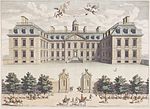The Arts Club
1863 establishments in the United KingdomArts in the United KingdomArts organizations established in the 1860sBritish artist groups and collectivesBuildings and structures in the City of Westminster ... and 3 more
Gentlemen's clubs in LondonMayfairUse British English from July 2015

The Arts Club is a London private members club founded in 1863 by, among others, Charles Dickens, Anthony Trollope, and Lord Leighton in Dover Street, Mayfair. It remains a meeting place for men and women involved in the creative arts either professionally or as patrons.
Excerpt from the Wikipedia article The Arts Club (License: CC BY-SA 3.0, Authors, Images).The Arts Club
Dover Street, City of Westminster Mayfair
Geographical coordinates (GPS) Address Website External links Nearby Places Show on map
Geographical coordinates (GPS)
| Latitude | Longitude |
|---|---|
| N 51.508191666667 ° | E -0.14222777777778 ° |
Address
The Arts Club
Dover Street 40, 40a
W1S 4NH City of Westminster, Mayfair
England, United Kingdom
Open on Google Maps





